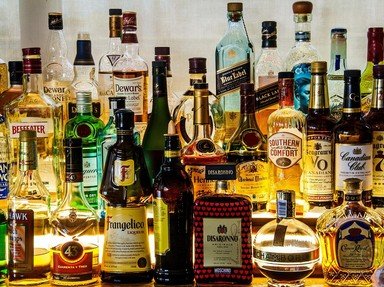Quiz Answer Key and Fun Facts
1. Our cruise started in Valencia, Spain. Some of us had a pre-cruise birding excursion to find Spanish specialties such as the great bustard and red-knobbed coot. Once aboard, our sommelier greeted us with a hearty "Salud!" He asked us if while in Spain, you were to try a glass of Cuarenta y Tres, one of Spain's most popular liqueurs, which beverage would you be savouring?
2. We next sailed into Marseille, and were greeted by the heady aroma of lavender wafting over the ship. Baguette slices with tapenade were proferred, and our sommelier posed his next question. Some monastic orders are known for the production of liqueurs and other drinks. What is the name of the herbal liqueur - also associated with a colour - produced in a monastery in southeastern France?
3. Palermo, in Sicily, was our next port of call. We were delighted to see broom in bloom on the hillsides. After cleansing our palate with slices of blood orange, we were presented with our next liqueur. The Italian liqueur sambuca is often served with the addition of what interesting complement - also an after-dinner favourite?
4. Next stop! The Grand Harbour in Valletta, Malta. We were sad that it was the wrong time of year to attend Carnival. We turned our attention to our next "sippable." In Malta they drink a rich red-coloured liqueur called Bajtra. Which perhaps surprising botanical is it based on?
5. We had an exciting shore excursion planned at our next port - we were invited to a barbecue to sample janjetina s raznja. Where are we headed? What country claims the fame of a maraschino liqueur?
6. As we sailed into Limassol on Cyprus, we were mesmerized by the waving flags, with the island's outline underscored by olive branches. The sommelier handed us each a sample of Filfar. What fruit is used in production of this liqueur?
7. Snacks of yaprak sarma, stuffed grape leaves, were handed out when we arrived in Izmir. We had more vocabulary to learn! If you visit the Greek island of Crete you will probably be offered their national drink tsikoudia, a pomace brandy. Confusingly it is sometimes known by another name which is the same as the national drink of Turkey. They however don't taste the same. What is the alternative name of tsikoudia?
8. Beirut was a sobering experience - the effects of the August, 2020 explosion were still evident. We wished we had been able to time travel to when it was a bustling port supplying the Crusades instead. Our tasting of "arak" at this port was a happier experience. Arak is a two-ingredient alcoholic beverage of the Eastern Mediterranean. One ingredient is the grape. What is the other ingredient?
9. We swung around to northern Africa, excited to visit Tunis. The Tophet of Carthage has been extensively excavated and is now a World Heritage Site, so we looked forward to going ashore, despite the gruesome history behind the Tophet. As alcohol is forbidden in Islam, the classical liqueurs from Tunis are produced by non-Muslims. Which group historically produced boukha?
10. Ah, we may always have Paris but Casablanca is also forever in our hearts. As we dined on a fabulous meal of couscous and vegetable stew, the sommelier returned with his next query. Mahia is a clear Moroccan eau de vie made from fruit and anise. What type of liqueur is it?
Source: Author
pusdoc
This quiz was reviewed by FunTrivia editor
Bruyere before going online.
Any errors found in FunTrivia content are routinely corrected through our feedback system.
